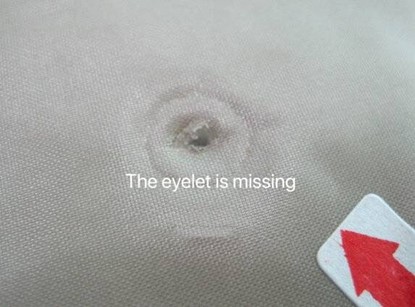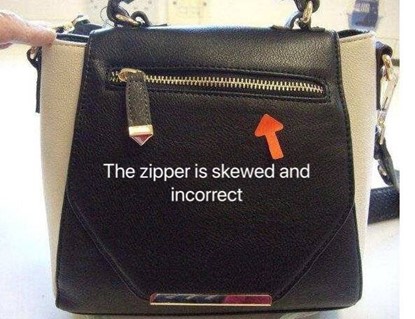Quality means doing it right when no one is looking, Henry Ford
AQL as secret behind your successful bags
AQL or acceptable quality limit is the secret behind your and our success. Your clients should see the design, the color, and the usability of the bag, but never the quality. This is something they should experience, without seeing it. The quality control as agreed will make this happen.
Thanks to the AQL tables your client can not see the quality, but will for sure for decades the great experience of your quality bag!
How is AQL part of quality control?
AQL is a statistical method that is the standard for quality control. Instead of inspection of every individual bag, parties agree to whether to accept or reject an order based on the number of defects found in the sample size. AQL sampling of bags makes stating requirements upfront and verifying them later with inspection much easier for you. When the factory is overseas, a method like AQL can be very beneficial and efficient for both parties.
When AQL is used the inspecting agency pulls a sample of bags at random from a lot. The inspector can test part of the lot and use those results to estimate the quality of the total lot. There is no excessive testing of the bags needed. This keeps the process efficient and at the lowest costs level. While you can still make informed decisions whether to ship the order based on the results of this inspection of bags.
The saving is also on the side of the factory, as a statistical method, will reduce the amount of waste. This will help to keep the cost of manufacturing the bags low.
A clear win-win in time and money for all parties involved. Let’s see what the AQL table recommends about the number of inspections.
AQL tables for bags

Lot size
The following tables can be used to determine the sample size depending on the lot size or order quantity. There is where it all begins, the size of your order. When you have an order quantity between the starting and end value of the table on the left side, you use the line of this range.
AQL – Inspection levels
Inspection levels are the main determinant of how many units you’ll pull for inspection. General inspection levels are most used for procedures that will be applied to your entire main sample size. You or the quality inspector would perform visual inspection procedures; such as examining a piece of furniture for any defects or non-conformities, on every unit in your sample.
There are three categories of levels, I, II or III. Where category I is offering a narrow inspection scope. Category III offers the widest scope and greatest transparency of the inspection levels. But at higher cost as mentioned before.
For bags most sampling standards are under Level II. Critical: 0, Major: 2.5, Minor:4.0. During the inspection process when the number of Critical, Major or Minor levels is found to exceed the standard, then the entire inspection result is considered to fail the quality control levels.
Then how to determine Critical, Major, Minor? Depending on the type of bags, backpack, cosmetic bags, or any other, specific customers or country related requirements, there will be different determination criteria.
For most products, according to the general definition the following points are taken into consideration (special products or special requirements are discussed in next post):
1. Critical: 0 – fatal defects.
In general, critical refers to the product fatal defects, the bag or accessories may cause injury or discomfort to consumers. Or will cause contamination of the product. Consumers might return the bags or file claims. All these inspection results will be determined as Critical. For most clients Critical is 0 acceptance, 0 tolerance. In general, these defects are sharp points, sharp edges, broken needles, sharp objects, insects, hair, blood stains, mold, and other such issues.
There is another category, such as the origin label printing error, or for the product UPC barcode is wrongly affixed or omitted. This will be reason to classify as Critical, but some will also classify this point as Major.
Once the problem is judged as Critical, then the whole batch of goods are to be returned.



2. Major: 1.5 or 2.5 – serious defects
Major refers to the product defects that are more obvious. These defects affect the appearance. There are no safety issues, but the defects are visible. These defects might have negative impact on the sales of these bags and will be classified as Major. For example, the product’s function is bad, the bag misses small accessories, all affecting the use of the product and thus are serious defects.3. Minor: 2.5 or 4.0 – minor defects / minor defects
Minor means that the product has minor defects. Defects that do not affect the use of the product, and do not affect the function of the bag. The purchase choice will not cause a major impact and can be determined as Minor. For example, threads showing, dirt, glue, minor printing defects, minor wrinkles, etc. these are all minor defects.Alternatives for AQL
You can also agree with the manufacturer alternatives for the quality control. However, these are less common in the bag industry.- Single sampling
- – this is the preferred sampling plan for most importers. You accept or reject a lot based on the results of inspecting only one sample. If the number of defects or nonconformities found is within the chosen AQL, the AQL result passes.
- Double sampling
- – this sampling plan combines two single sample plans, conducted separately one after another. The main advantage to double sampling is that if the number of defects or non-conformities found in the first sample isn’t well within the acceptance point or well more than the rejection point, then inspecting a second sample helps provide a clearer result.
- Continuous sampling
- – with continuous sampling, you typically begin by inspecting 100 percent of the units consecutively produced as they come off the production line. Once you’ve found a certain number of consecutive units to be free of defects and non-conformities, you’d begin checking a random sample. If a single unit in the sample is found to be defective, you’d repeat the process from the beginning, inspecting 100 percent. Continuous sampling is most often used with conveyer line production, or when lot-by-lot inspection isn’t practical.
- Zero acceptance sampling (c=0)
- – with “c” being the number defects allowed, zero acceptance sampling involves rejecting an order if a single defect or nonconformity is found in the inspected sample. This sampling plan is rarely used by importers and requires smaller sample sizes but presents greater producer risk.
